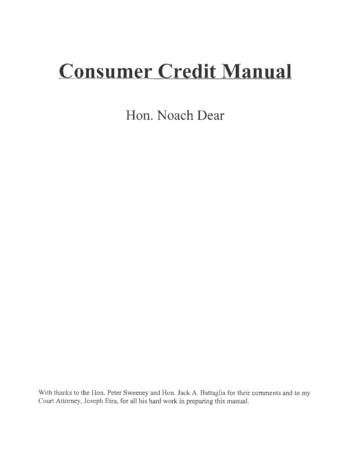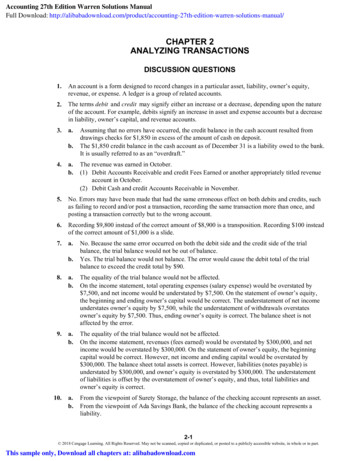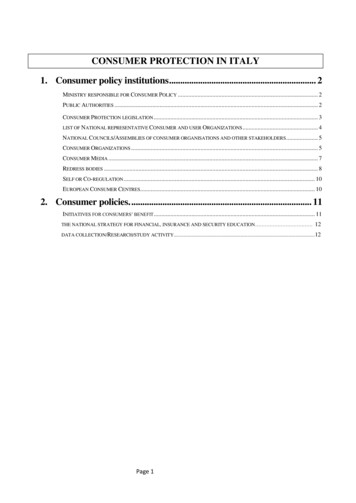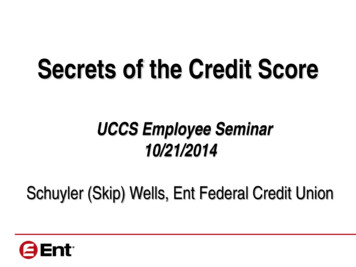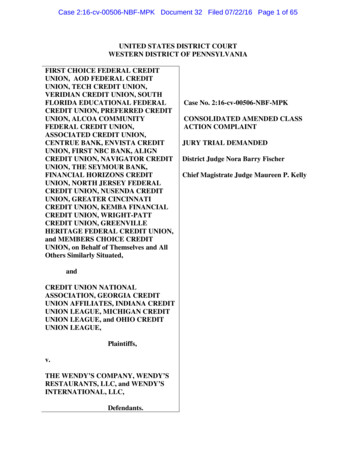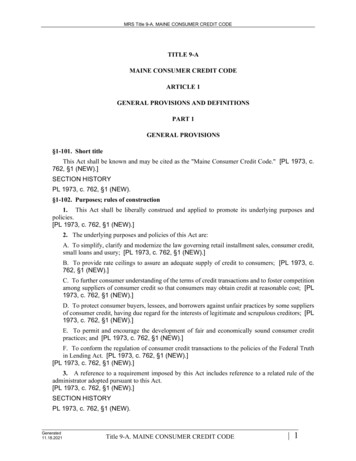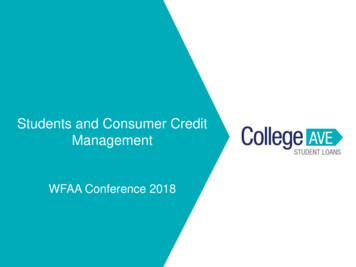
Transcription
BANK OF ITALYGUIDESCONSUMERCREDITmade easyOPTIONS and COSTSConsumer RIGHTSUseful CONTACTSConsumer creditfrom A to Z
Banca d’ItaliaVia Nazionale, 9100184 RomeTel. 39 06 47921Certified e-mail: bancaditalia@pec.bancaditalia.ite-mail: email@bancaditalia.itISSN 2612-5072 (online)ISSN 2612-4726 (print)Designed and printed by the Printing and Publishing Division of the Bank of Italy
consumer creditConsumer credit is money lent for the purchaseof goods and services required by the consumeror by the consumer’s family – a car, a householdappliance or a language course – or to deal withsituations requiring you to have cash available. A‘consumer’ is a person who purchases somethingfor private rather than professional use.A loan may range from 200 to 75,000 and isgranted by a bank or by an authorized financialcompany, or also by a provider of goods andservices such as a retailer or a car dealer.A useful way to buy something importantfor you or your family.
What’s inside?iHow to choose a loan?4Types of loan6How much does it cost?How to read advertisementsHow to apply for a loan!Main risks and issues8111316My rights20Explanations? Complaints?Useful contactsConsumer creditfromAZChecklistto222327
?How to choose a loan?Before I choose, I need to ask thefollowing questionsWhat is a consumer loan?It is a loan that can only be requested for personal needs,which are connected to your private, family life. When a loan isneeded to purchase something – for example, a car, a televisionor a training course – it’s called a special purpose loan or a‘linked credit agreement’ and the lender usually pays the sumdirectly to the seller. However, if a loan is requested becausecash is required, then it is called a non-specific loan.Consumer credit therefore does not include any kind of loanfor any needs to do with professional activities, such as buyingagricultural machinery or a printer for a shop.What isn’t a consumer loan?4Even if a consumer asks for the following loans for privateneeds, they are not considered ‘consumer loans’: loans of less than 200 and more than 75,000 loans that don’t involve interest payments or other costs loans to buy land or an existing or projected building loans with a duration of more than five years secured by amortgage or lien on immovable property overruns, or rather the occasional authorized use of amountsgreater than that of a current account balance or of anoverdraft ( Consumer credit from A to Z) agreed for acurrent account.The loans excluded from ‘consumer credit’ are listed in the TestoUnico Bancario (Consolidated Law on Banking), available on theBank of Italy’s website ( /Testo-Unico-Bancario.pdf)When a loan is covered under the definition of‘consumer credit’, the law envisages particular consumerprotection and rights compared with other types of loan.Bank of Italy Guides
Consumer Credit made easyWho can I ask for a loan?A lender, i.e. banks and authorized financial companies( Consumer credit from A to Z).The lender can use agents and credit brokers, who are creditintermediaries ( Consumer credit from A to Z).If the loan is for purchasing a good or service, you can oftenapply directly to the point of sale, such as hypermarkets orcar dealers that prepare everything for the loan contractconnected to the sale.Who can ask for and get a loan?Anyone can ask for a loan. However, to get a loan you have toprove that you can pay back the amount of the loan on the setdeadlines. This is known as creditworthiness and is assessed bythe lender before the loan is granted.How is creditworthiness assessed?Before concluding the contract or before agreeing to asignificant increase in the amount to be lent, the lender hasto collect information on the consumer’s ability to pay backthe loan, and can do so by consulting a data base. There arepublic and private data bases that collect information on loansobtained by individuals and also any negative information, suchas a refused loan or the non-payment of instalments.Beware!Don’t trust anyone who promises easy loans toeveryone. Always carefully check the interestrates, the extra or ancillary expenses and theeconomic conditions provided for in the contract.That way you’ll avoid getting caught out by highcosts, which might prevent you from being able torepay the money you borrowed.5
iTypes of loanConsumer credit includes different types of loans. These arethe most common ones: non-specific loan opening a current account credit facility revolving credit card special purpose loan or ‘linked credit agreement’Non-specific loanPersonal loanA personal loan is usually granted for general cash needs. Thelender pays a lump sum to the consumer who then pays it backin instalments. As protection against the risk of non-repayment,the lender can ask for personal guarantees such as a surety( Consumer credit from A to Z) and/or an insurance policy.6Loans against one fifth of salary or pension and deduction of paymentsThe law allows employees (public and private) and pensionersto pay back loans granted by using up to one fifth of theirsalary or pension. In this case, the employer or pension fundwithholds the instalment from the salary or pension and paysit to the lender.Pensioners can only ask for the transfer of a fifth part becauseonly one payment can be withheld from their pension, whichcannot exceed one fifth of the monthly amount received.Employees, however, can ask for bigger loans and use a furtherfifth of their salary; in this case, as well as using one fifth of theirsalary, they must also enter into a ‘deduction of payment’contract with the lender ( Consumer credit from A to Z).The employer is obliged to respect salary-backed loans but candecide whether or not to approve the deduction of a furtherfifth of a salary. Salary-backed loans are legally required to havean insurance policy to cover the risk of the debtor’s death and/or loss of employment.Anyone who requests a salary-backed loan enjoys all the rightsand protections provided for by consumer credit regardless ofthe amount of the loan.Bank of Italy Guides
Consumer Credit made easyOpening a current account credit facilityThe bank agrees to make a fixed maximum amount available ona client’s current account. To access this money the client hasto pay a fee to the bank, but only pays the interest indicated inthe contract on the amounts used. When the client pays backpart or all of the amount used, with interest, the amount willbecome available for use again.Loan with a revolving credit cardWith a revolving credit card, the cardholder not only has apayment instrument but also receives a real loan, which canbe used to make purchases directly at retailers or to withdrawcash.The loan is repaid in instalments and with interest at a rate thatis usually variable. The card can be used until the maximum limitset by the lender is reached.Every time the amount used (the principal), is paid back throughinstalments, this amount can be spent again by using the card.This is why it is called a ‘revolving’ card.Beware!Interest rates on loans granted with a revolving creditcard may be higher than those for other types ofconsumer loans.The minimum instalment payment is usually low, andthis is why you need to check the loan documentationto see the share of the instalment (the principal) thatcontributes to reducing the amount of the residualdebt. Otherwise there is the risk that the duration ofthe loan will be extended and it will take much longerto pay it back.Special purpose loanA special purpose loan or ‘linked credit agreement’, is a loan forthe purchase of a particular good or service, to be paid back ininstalments. A consumer can get this type of loan directly from aseller that has an agreement with one or more banks or financialcompanies and usually manages the loan on their behalf.The contract must include a detailed description of the goods orservices and an indication of what they cost.7
How much does it cost?Getting a consumer loan involves costs: interest, fees and otherexpenses. Fees include, for example, the costs of starting andmanaging a loan; other expenses may be taxes or insurance.Some fees and expenses are fixed, regardless of the amount ofthe loan, so they will have a greater impact if the amount of theloan requested is low, for example under 1,500.These costs taken together are the ’total cost of financing’ andthese are the indicators for its evaluation:TAN (in Italian Tasso annuo nominale)8The TAN or ‘annual nominal interest rate’ indicates the ‘pure’interest rate, as a percentage of the loan granted and on anannual basis. ‘Pure’ means it doesn’t include costs or fees anddoesn’t indicate the ‘total cost of financing’, which is insteadexpressed in the TAEG or Annual Percentage Rate of Charge(APR). So a loan with a TAN of zero could have an APR that’smuch higher than zero.Advertisements and the documentation for the offer mustalways show the TAN and specify whether it’s fixed or variable.APR - (in Italian TAEG - Tasso annuo effettivoglobale)The APR (Annual Percentage Rate of Charge), expressed as apercentage of the loan granted and on annual basis, includesall the costs, so it’s very useful for understanding which loan ismost suited to your needs and what you can afford.The APR is the main instrument for transparency in consumerloan contracts. As well as including all costs, it’s also aharmonized index at European level. This makes it possible tocompare all loans quickly and easily, including those offered byforeign operators on the Italian market.Even so, the APR might not correspond exactly to the costsactually incurred. Opening a current account credit facility orhaving a revolving credit card, for example, might have coststhat depend on unpredictable elements, such as fluctuationsin interest rates and how frequently people use and repayloans. In these cases the representative example that a lenderis obliged to indicate in the loan documentation is particularlyuseful.Bank of Italy Guides
Consumer Credit made easyThe APR includesThe APR doesn’tinclude the TAN (or annualnominal interestrate) any penaltiesor default interestif the consumerdoesn’t pay theinstalmentsor doesn’t pay themon time fees, includingthose for creditintermediaries additional expensespaid in cash or bycredit card at thetime of purchase,for examplefor delivering thegood purchasedor for takingthe old one away taxes notary fees other costs and expenses forexpenses linked tooptional extraextra servicesservices (for(for example,example, optionalinsurance policies)insurance policies)required by lawor in any casenecessary to get orcontinue use loansunder the conditionsoffered, unless theycannot be quantifiedin any way when theAPR is calculated(in this case extraservices areindicated separately)By law, the APR must always be shown in advertisements, inthe loan documentation and in the contract. The APR must beshown in the same way as all other costs and information inadvertisements.9
Here’s an example of anon-specific personal loanAmount granted 10,000Duration of loan60 monthsMonthly instalment 216.9No. of instalments60TAN 10.9%APR* 11.6%* The APR includes substitute tax ( 25) and the cost ofsending a periodic statement ( 3).10The cost of the loan cannot be higher than the‘usury’ ceiling, above which it becomes illegal.The AOER and usuryThe AOER (Average Overall Effective Rate) is the referencerate for calculating the usury ceiling ( Consumer credit fromA to Z), above which a loan becomes illegal. It representsthe quarterly average of the Overall Effective Rates (OER)applied by all lenders to individual types of loan (for example:opening a current account credit facility, personal loans orsalary-backed loans). The AOER takes account of all theexpenses connected with loans, excluding taxes and duties.To make sure that the rate applied isn’t illegal, you need tofind out the ‘ceiling rate’ on the type of loan you’re interestedin and compare it with the rate actually applied to your loan.Lenders must display the ceiling rate table on their websitesand in their offices, and it can also be consulted on the Bankof Italy’s website ( nguage 1).Bank of Italy Guides
Consumer Credit made easyHow to readadvertisementsPromotional messages and advertisements give an initial ideaof the loan deals offered to consumers. To make it easy forconsumers to evaluate offers, the law requires that advertisingis as clear and understandable as possible. If the advertisementsof lenders and of sellers of goods and services show the TANor other figures relating to loan costs (zero is a number too!),they must: show the important information in a clear, concise andprominent way compared with the other details: the annualinterest rate, the expenses that determine the total cost ofthe loan or the maximum amount that can be made available,the duration of the contract, the total amount owed and theamount of the individual instalments (if that can be decidedin advance) the APR must be shown in the same way as all the otherinformation a clear example must be given which shows all the differentfeatures of the loan indicate any obligation to sign contracts for one or moreextra services, unless the costs connected with the contractare already included in the APR.Beware of adverts that talkabout ‘zero-interest loans’!You must check that not only the TAN butalso the APR on the loan are zero.11
The TAN (annual nominal interestrate) is the pure rate of interest thatdoesn’t include costs or fees.If the overall costs were zerothen the monthly instalmentswould come to 138.9.However, in the example theamount shown for the instalmentsincludes 3 of monthly costs.Example12You buy a language course foryour children at zero interest!Amount grantedMonthly instalmentsFixed TANTAEG 5,00036 instalments of 141.905.6%Costs included in the APR:- monthly costs 3- arrangement costs 300The APR expresses the total cost ofthe loan because it includes expensesand fees. This means it might be a lothigher than the TAN. In the examplethe APR includes arrangement costs of 300 and monthly costs of 3.Bank of Italy Guides
Consumer Credit made easyHow to applyfor a loanWho can I apply to?A bank or an authorized financial company which can usecredit intermediaries: financial agents and credit brokers,entered on the Lists kept by the OAM - Organismo degliAgenti e dei Mediatori (Agents and Brokers Organization)( Consumer credit from A to Z).Agents act directly on behalf of lenders and can concludeloan contracts. Credit brokers, on the other hand, areindependent subjects who can promote loans but cannotconclude contracts; they request a fee for their activitieswhich they agree with the consumer.You should always check whether a credit broker is enteredon the OAM Lists. The lists also contain information oncorrect business practices. If someone is found to operatein an irregular way, the OAM should be informed ( www.organismo-am.it).Sometimes a bank or a financial company can be a credit brokerbecause it proposes loans for other banks or companies.If the loan is for purchasing a good or a service, you can applydirectly to the point of sale, for example a supermarket or acar dealer. In this case the seller prepares everything for theloan contract linked with the sale.How to choose the most suitable loanThe lender or the credit intermediary must provide theconsumer with all the information necessary to assess itsoffer and compare it with other offers on the market. Inthis phase consumers set out their needs and express theirpreferences.The lender or intermediary must supply a SECCI form(Standard European Consumer Credit Information) freeof charge ( Consumer credit from A to Z). This must bedone before the consumer signs a loan contract or makesan irrevocable commitment, so that they have plenty of timeto think it over. As part of its standardized format, the formmust indicate the contractual conditions according to thecustomer’s characteristics and needs; any information that isnot covered by the SECCI should be provided in a separatedocument.13
The SECCI form must indicate:14 the main features of the loan, for example: the type ofcontract, the amount, the duration, the instalments, thegood or service and the price if it’s a special purpose loan,and the guarantees information on the loan costs: interest rate and APRwith details of the costs included and not included and arepresentative example other legal aspects, such as: consultation of a data base, theright to receive a copy of the contract before signing it, theright of withdrawal, early repayment and the consequencesof non-payment of instalments additional information if the products are marketed from adistance (online or by phone).If the information received is insufficient or difficult tounderstand, the consumer can contact the lender for help.The lender has to provide assistance, at least during normaloffice hours and by means of individual, face-to face or phonemeetings. The consumer has the right to receive assistancefrom credit intermediaries as well.Before concluding the contract and for the entire period inwhich the right to withdraw can be exercised, the lender isobliged to provide the consumer, free of charge, with completeexplanations of the loan’s basic features, the contractualconditions, the obligations arising from the contract and theconsequences of non-payment of instalments.Consumers have the right to request a copy free of charge ofthe contract ready to be signed, so that they can take theirtime and look at it at home.SuggestionsIn order to assess the interest rate offered and look for thecheapest product on the market, it’s a good idea to compare theSECCI forms for the proposals of one or more intermediaries,using the APR as a benchmark.Information is available on intermediaries’ websites where youcan often get free and personalized quotes.For comparisons to be useful, the characteristics of theloan requested (for example type, amount, length of timeand number of instalments) need to be the same for allintermediaries under consideration.Before concluding a loan contract it’s advisable to assessBank of Italy Guides
Consumer Credit made easywhether you really need to take out the loan and to make surethat your income is sufficient to pay the instalments over time.For this reason, you always need to consider that unexpectedevents may occur over the duration of the loan that mightrequire new outgoings (medical expenses, spending on yourhouse or your children) or that reduce your income (job loss,wage supplementation, illness).When you have an ongoing loan, you must be careful abouttaking out other ones, as you run the risk of not being able topay all the instalments.You can ask lenders and credit intermediaries for help in thesematters too.What documents do I need?The lender asks the consumer for certain paperwork anddocuments in order to set up the loan and assess their abilityto repay it:15 a form of identification tax code employee: pay packet and CUD (your employee taxstatement) member of the professions or self-employed worker: incometax returns (730 or ‘modello unico’) pensioner: pension payslip or National Social Security(INPS) certification documentation of any other ongoing loans.Non-Italian consumers might be asked to providedocumentation to prove that they are legally resident in Italy.Bear in mind that: loans are usually granted to people between 18 and70 years of agethe lender may ask for a guarantee from a thirdperson who agrees to pay in the event of theconsumer’s non-payment. In this case, the thirdperson or guarantor must provide documentationdemonstrating their ability to pay.15
!Main risks and issuesCreditworthiness16Before concluding a contract or granting a significant increasein the amount of the loan, the lender is obliged to assess theconsumer’s ability to repay the loan, both by requesting theinformation directly from the consumer and by consulting adata base: the Central Credit Register or a Credit reportingSystem (CRS) ( Consumer credit from A to Z).If a loan application is refused on the basis of a data baseconsultation, the consumer has the right to be informedimmediately and free of charge, with an indication of the database used and the results of the consultation.The first time that the lender reports negative information toa data base about a consumer (for example continuous nonpayment of instalments), the latter, together with anyone elseinvolved in the payments (for example the guarantor), must beinformed in advance, so that they can challenge the report ifthey want to.Consumers can also consult the data contained in the CentralCredit Register and in the CRSs, and find out who made reportsconcerning them. If they think that the information concerningthem is incorrect, they can challenge it and ask for it to beverified and corrected. To do so, they can directly contact theperson who made the report on them or they can write to thedata base manager.Everyone is entitled to find out about any data in their namecontained in the Central Credit Register. Access is free of chargeand you can go online quickly and securely ( www.bancaditalia.it/ser vizi-cittadino/ser ge.language 1).Insurance coverInsurance cover is the choice of the customer, even thoughmany banks and financial companies request it as a protectionagainst non-payment.If the bank or financial company asks for a life insurance policy, ithas to accept any policy that the customer presents or finds onthe market, without making any changes to the conditions of theloan provided, as long as the policy provides an equivalent level ofprotection to that proposed by the intermediary. If the customeraccepts the insurance policy offered by the intermediary, theymust be informed about the commission paid by the insurancecompany to the intermediary. You must be careful as to howmuch the policy costs, as the one proposed by the intermediaryBank of Italy Guides
Consumer Credit made easymight be more expensive than others on offer on the market.For salary-backed loans, a policy to cover the risk of job lossand/or death is required by law. This kind of insurance covermay often be required by means of deduction of payments too.The law provides for the protection of insurance policies aswell ( htmlpage.language 3).Relationship with the sellerThe seller can allow the consumer to pay in instalments(‘deferred payment of the price of goods and servicespurchased’), but without asking for payment of interest orother costs.However, if the seller promotes or concludes loan contracts, itcan only be on behalf of a lender and only for the purchases ofgoods and services that the seller markets.A seller cannot, for example, sell revolving credit cards. If thisoccurs, it should be formally reported to the Bank of Italy.If the seller doesn’t deliver the goods or doesn’t provide theservices purchased, or in certain cases if there is a seriousdefect, the consumer can contact the lender to terminate theloan agreement, but only after contacting the seller in writingto request repayment of the money owed and receivingno positive answer. If the loan agreement is terminated, theinstalments and any other amounts paid to the seller must berefunded by the lender.Right to withdrawThe consumer can withdraw from the agreement within14 days of signing it by notifying the lender according to theprocedure the latter stipulates. Consumers can withdrawwithout giving any reason. If the consumer has received theloan in the meantime, even only partially, within 30 days ofcommunicating their withdrawal, he or she must repay themoney received and pay the interest accrued up until the dateof repayment.Withdrawing from the loan contract also means withdrawingfrom the related extra or ancillary services, provided by thelender or by third parties, unless the latter show that theyprovide these services independently, or rather outside anyagreement with the lender.If the contract is an open-ended one, the consumer canwithdraw at any time, without any penalty or costs. In this17
case, the contract may require a notice period of no longerthan one month. The lender can also withdraw, but must notifythe consumer at least two months beforehand. The lendercan also suspend the loan, but with just cause – for example,the suspected theft of the credit card – and must notify theconsumer first.Non-payment of instalments18If the loan is paid back in instalments, which are usually monthly,before asking for a loan it’s important to assess your monthlyresources, or rather how much money you have left after yourbills and other instalments have been deducted from yoursalary.In the event of non-payment of instalments, the lender canbe reimbursed from the guarantee and resort to any of themeasures provided for by law to collect payment, from sendingformal payments to recourse to the courts.The non-payment of even one instalment may mean highercosts for the consumer, starting with interest on arrears, whichisn’t included in the APR.In more serious cases the lender can have the contractterminated, which obliges the consumer to repay the amountoutstanding immediately.Another consequence of non-payment of instalments is thatthe lender reports this negative information to the CentralCredit Register or to the CRSs. This kind of report may makeit difficult to get a loan in the future.All the possible consequences of non-payment must beincluded in the loan documentation and in the contract.Changes in contractual conditionsSome contractual conditions may change from the time whenthe contract is signed. Changes may depend on the client forexample, as their financial situation may deteriorate, or theymay be due to external circumstances, such as the generaleconomic situation. In such cases the lender can unilaterallychange the initial contractual conditions only if: the contract expressly stipulates the right of the lenderto change the contractual conditions and if the client hasexpressly approved this clause; there is a justified reason. It must be something thathappened after the conclusion of the contract and must bewell-documented. Under no circumstances can the lenderBank of Italy Guides
Consumer Credit made easyintroduce a condition that is entirely new compared withthe initial ones.Interest rates can only be changed for long-term contracts. Inthis case, the proposal must also show how the change willaffect the amount owed and the instalment schedule.Every time the lender wants to change one or more conditions,they must send a communication to the consumer entitled‘Proposal for a unilateral change to the contract’.The proposal must clearly explain the reasons for the change,so that the consumer can decide if the change is justified, andit must be sent at least two months before the change comesinto force.If the consumer agrees with the reasons and accepts thechange, they don’t have to do anything. However, if they wantto refuse the proposal, then they must notify the lender of theirintention to terminate the contract before the change comesinto force. No reason needs to be given for the decision andthere are no costs, but the amount already received will haveto be repaid with interest under the conditions prior to theproposed change.Early repaymentThe consumer may at any time make an early repayment ofsome or all of the amounts due. In this case the consumer isentitled to a reduction of the loan costs since the durationof the contract is also reduced. Apart from a few exceptions,the lender could ask for compensation for costs directly linkedto the early repayment, which must be clearly justified. Thecompensation can’t be more than 1% of the amount repaid ifthe contract has more than one year left to run, or 0.5% if ithas one year or less to run.19
My rightsA consumer that gets a ‘consumer loan’ has a series ofrights guaranteed by law. It’s important to know whatthese are to make the best choice and one that is mostsuited to your needs.When choosing your loan20 You receive all the information you need to comparevarious offers free of charge from the lender or the creditintermediary. You can get a free copy of this Guide and keep it with you. You can get a SECCI form free of charge and keep itwith you. If you open a current account credit facility, theSECCI information can also be found in the documents ontransparency relating to the current account. The lender or the credit broker will explain everything toyou free of charge. You can get a complete copy of the contract free of chargeand keep it with you, also before the contract is concludedwith no commitment on either side. You can also access the SECCI form and a complete copyof the contract on the lender’s website in cases where acontract can be concluded online. You need to know what the APR is and what the totalamount owed is. The lender has to inform you immediately and free ofcharge if your loan application is refused based on theconsultation of a data base, and must specify which database was used and the information that was provided. Ask the data base indicated by the lender for a copy of theresult of the consultation. You have to be informed about the possibility andconsequences of early repayment of your loan. You have to be informed about how to withdraw from acontract and what the deadlines are for withdrawal.When signing the contract Don’t accept contractual conditions that are less favourablethan those shown on the SECCI form or in any other loandocumentation.Bank of Italy Guides
Consumer Credit made easy Choose how you want to receive communications, eitherin digital or paper format. Online communicatio
Consumer Credit made easy Consumer credit includes different types of loans. These are the most common ones: non-specific loan opening a current account credit facility revolving credit card special purpose loan or 'linked credit agreement' Non-specific loan Personal loan A personal loan is usually granted for general cash needs. The

